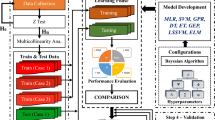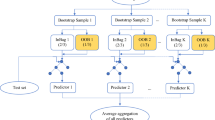Abstract
Rock mass is a complex structure and its mechanical behavior is significantly influenced by the joint frequency and orientation. The evaluation of rock mass strength is a key element in rock mechanics applications. In accordance with the advancement of computer aids in this field, the functionality of various machine-learning (ML) models needs to be explored for triaxial rock mass strength estimation. To bridge this gap in research, hybrid surrogate models, i.e., lazy locally weighted learning (LWL) method combined with Gaussian process regression (GPR) and support vector regression (SVR) algorithms are developed to estimate the triaxial strength of rock mass. An experimental published database of triaxial compressive strength of jointed rock is used for constructing the ML models, whose input parameters contain the joint frequency, joint orientation, and confining stress. Subsequently, the ML models of GPR and SVR, an instance of kernel-based algorithms, are first constructed and analyzed. The effect of the different kernel functions namely radial basis function kernel (RBF), Pearson VII function-based universal kernel (PUK), and polynomial kernel function on the performance of the GPR and SVR models is also analyzed. Then, these probabilistic and stochastic algorithms are considered as a classifier in the LWL-based model to predict triaxial rock mass strength. Finally, the comparison is performed to evaluate the performance of proposed surrogate models. The results demonstrate that the computational hybrid LWL-SVR and LWL-GPR models based on RBF, PUK, and polynomial kernels as well as individual GPR and SVR models based on RBF and PUK kernels (root mean squared error (RMSE) < 1.54 MPa, coefficient of determination (\({R}^{2}\)) > 0.996, mean absolute error (MAE) < 1.32 MPa, and relative absolute error (RAE) < 7.75% for the training and testing datasets) can be successfully applied for estimation of triaxial compressive strength of jointed rock. The sensitivity analysis results of the proposed models indicate that the confining pressure is the most influential variable on the triaxial strength of the jointed rock in all ML models.







Similar content being viewed by others
References
Arunakumari G, Latha GM (2008) Stress-strain prediction of jointed rocks using artificial neural networks. In: 12th international association for computer methods and advances in geomechanics (IACMAG), Goa, India, 1872–1879
Atkeson CG, Moore AW, Schaal S (1997a) Locally weighted learning for control. Lazy Learn. https://doi.org/10.1007/978-94-017-2053-3_3
Atkeson CG, Moore AW, Schaal S (1997b) Locally weighted learning. Artif Intell Rev 11:11–73. https://doi.org/10.1023/A:1006559212014
Colak K, Unlu T (2004) Effect of transverse anisotropy on the Hoek-Brown strength parameter’mi’for intact rocks. Int J Rock Mech Min Sci 41(6):1045–1052. https://doi.org/10.1016/j.ijrmms.2004.04.004
Fathipour-Azar H (2021a) Machine learning assisted distinct element models calibration: ANFIS, SVM, GPR, and MARS approaches. Acta Geotech. https://doi.org/10.1007/s11440-021-01303-9
Fathipour-Azar H (2021b) Data-driven estimation of joint roughness coefficient (JRC). J Rock Mech Geotech Eng 13(6):1428–1437. https://doi.org/10.1016/j.jrmge.2021.09.003
Fathipour-Azar H (2022) New interpretable shear strength criterion for rock joints. Acta Geotech. https://doi.org/10.1007/s11440-021-01442-z
Fathipour Azar H, Torabi SR (2014) Estimating fracture toughness of rock (KIC) using artificial neural networks (ANNS) and linear multivariable regression (LMR) models. In: 5th Iranian Rock Mechanics Conference
Fathipour-Azar H, Saksala T, Jalali SME (2017) Artificial neural networks models for rate of penetration prediction in rock drilling. J Struct Mech 50(3):252–255. https://doi.org/10.23998/rm.64969
Fathipour-Azar H, Wang J, Jalali SME, Torabi SR (2020) Numerical modeling of geomaterial fracture using a cohesive crack model in grain-based DEM. Comput Part Mech 7:645–654. https://doi.org/10.1007/s40571-019-00295-4
Friedman JH (1995) Intelligent local learning for prediction in high dimensions. In: International Conference on Artificial Neural Networks, Paris, France
Gokceoglu C, Yesilnacar E, Sonmez H, Kayabasi A (2004) A neuro-fuzzy model for modulus of deformation of jointed rock masses. Comput Geotech 31(5):375–383. https://doi.org/10.1016/j.compgeo.2004.05.001
Goshtasbi K, Ahmadi M, Seyedi J (2006) Anisotropic strength behaviour of slates in the Sirjan-Sanadaj zone. Journal of the Southern African Institute of Mining and Metallurgy 106(1):71–75. https://hdl.handle.net/10520/AJA0038223X_3173
Hoek E, Brown ET (1980) Empirical strength criterion for rock masses. J Geotech Eng Div 106(9):1013–1035. https://doi.org/10.1061/AJGEB6.0001029
Huang F, Shen J, Cai M, Xu C (2019) An empirical UCS model for anisotropic blocky rock masses. Rock Mech Rock Eng 52(9):3119–3131. https://doi.org/10.1007/s00603-019-01771-2
Kiattisak S (2018) Effect of joint frequency and orientation on compressive strength and deformability of small-scale rock mass models, Master of Engineering in Civil, Transportation and Geo-resources Engineering, School of Geotechnology Institute of Engineering Suranaree University of Technology
Kulatilake PHSW, Park J, Malama B (2006) A new rock mass failure criterion for biaxial loading conditions. Geotech Geol Eng 24(4):871–888. https://doi.org/10.1007/s10706-005-7465-9
Moomivand H (2014) Effects of orientation, frequency, and number of sets of discontinuities on rock strength under triaxial stresses. Arab J Geosci 7(12):5345–5352. https://doi.org/10.1007/s12517-013-1069-0
Ramamurthy T, Arora VK (1994) Strength predictions for jointed rocks in confined and unconfined states. Int J Rock Mech Mining Sci Geomech Abstr 31(1):9–22. https://doi.org/10.1016/0148-9062(94)92311-6
Rasmussen CE, Williams C (2006) Gaussian processes for machine learning. MIT Press, Cambridge
Reyes O, Cano A, Fardoun HM, Ventura S (2018) A locally weighted learning method based on a data gravitation model for multi-target regression. Int J Comput Intell Syst 11(1):282–295. https://doi.org/10.2991/ijcis.11.1.22
Saroglou H, Tsiambaos G (2008) A modified Hoek-Brown failure criterion for anisotropic intact rock. Int J Rock Mech Min Sci 45(2):223–234. https://doi.org/10.1016/j.ijrmms.2007.05.004
Shamshirband S, Esmaeilbeiki F, Zarehaghi D, Neyshabouri M, Samadianfard S, Ghorbani MA, Mosavi A, Nabipour N, Chau KW (2020) Comparative analysis of hybrid models of firefly optimization algorithm with support vector machines and multilayer perceptron for predicting soil temperature at different depths. Eng Appl Comput Fluid Mech 14(1):939–953. https://doi.org/10.1080/19942060.2020.1788644
Singh M, Singh B (2012) Modified Mohr-Coulomb criterion for non-linear triaxial and polyaxial strength of jointed rocks. Int J Rock Mech Min Sci 51:43–52. https://doi.org/10.1016/j.ijrmms.2011.12.007
Taylor KE (2001) Summarizing multiple aspects of model performance in a single diagram. J Geophys Res Atmos 106(D7):7183–7192. https://doi.org/10.1029/2000JD900719
Thaweeboon S, Dasri R, Sartkaew S, Fuenkajorn K (2017) Strength and deformability of small-scale rock mass models under large confinements. Bull Eng Geol Env 76(3):1129–1141. https://doi.org/10.1007/s10064-016-0871-9
Vapnik V (1995) The nature of statistical learning. Springer, New York
Vapnik V, Vapnik V (1998) Statistical learning theory. Springer, New York
Wang T, Xu D, Elsworth D, Zhou W (2016) Distinct element modeling of strength variation in jointed rock masses under uniaxial compression. Geomech Geophys Geo-Energy Geo-Res 2(1):11–24. https://doi.org/10.1007/s40948-015-0018-7
Yang Y, Zhang Q (1997) A hierarchical analysis for rock engineering using artificial neural networks. Rock Mech Rock Eng 30(4):207–222. https://doi.org/10.1007/BF01045717
Yang ZY, Chen JM, Huang TH (1998) Effect of joint sets on the strength and deformation of rock mass models. Int J Rock Mech Min Sci 35(1):75–84. https://doi.org/10.1016/S1365-1609(98)80024-5
Zhou C, Karakus M, Xu C, Shen J (2020) A new damage model accounting the effect of joint orientation for the jointed rock mass. Arab J Geosci 13(7):1–13. https://doi.org/10.1007/s12517-020-5274-3
Funding
None.
Author information
Authors and Affiliations
Corresponding author
Ethics declarations
Conflict of interest
The author declares no conflict of interest.
Additional information
Publisher's Note
Springer Nature remains neutral with regard to jurisdictional claims in published maps and institutional affiliations.
Rights and permissions
About this article
Cite this article
Fathipour-Azar, H. Hybrid machine learning-based triaxial jointed rock mass strength. Environ Earth Sci 81, 118 (2022). https://doi.org/10.1007/s12665-022-10253-8
Received:
Accepted:
Published:
DOI: https://doi.org/10.1007/s12665-022-10253-8




